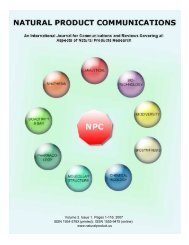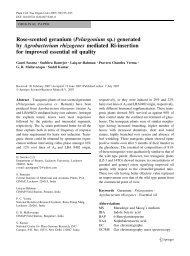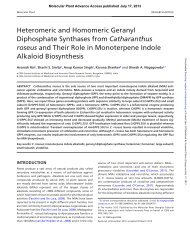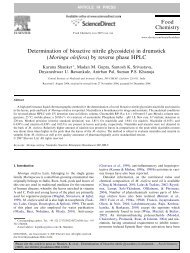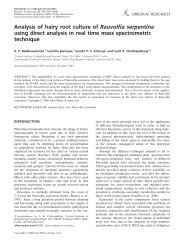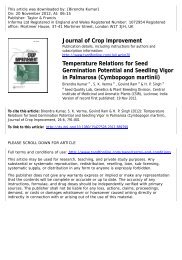Recent advances in plant hepatoprotectives - CIMAP Staff - Central ...
Recent advances in plant hepatoprotectives - CIMAP Staff - Central ...
Recent advances in plant hepatoprotectives - CIMAP Staff - Central ...
You also want an ePaper? Increase the reach of your titles
YUMPU automatically turns print PDFs into web optimized ePapers that Google loves.
752<br />
*<br />
NEGI ET AL.<br />
been reported to possess antiradical mechanism, scaveng<strong>in</strong>g free radicals by donat<strong>in</strong>g the allylic<br />
hydrogen atoms of the a/b unsaturated lactone either by homolytic cleavage or by deprotonationoxidation<br />
mechanism (Fig. 5). 57<br />
E. Toxicity and Side Effects<br />
Andrographolide and neoandrographolide were found to be safe. But, their oral adm<strong>in</strong>istration<br />
may cause poor appetite and sometimes vomit<strong>in</strong>g, due to its extreme bitter taste. 58 Extended oral<br />
adm<strong>in</strong>istration of these compounds on rats and rabbits at 1 g/kg dosage for a week did not produce any<br />
significant changes <strong>in</strong> the body weight, blood chemistry, hepatic and kidney functions. The LD 50 for<br />
andrographolide and neoandrographolide was found to be more than 40 and 20 g/kg <strong>in</strong> oral doses <strong>in</strong><br />
mice. 59<br />
F. Future Prospects<br />
These diterpenoid lactones have shown potent hepatoprotective activity aga<strong>in</strong>st various k<strong>in</strong>ds of liver<br />
disorders ma<strong>in</strong>ly as antidiarrhoeal agents. However, their hepatoprotective activity aga<strong>in</strong>st viral<br />
hepatitis is questionable. Extensive research attempts possibly through double bl<strong>in</strong>d cl<strong>in</strong>ical trials are<br />
required to establish its potency. Extremely high bitterness is another problem associated with this<br />
drug and efforts to suppress or hide this property might recommend it for oral adm<strong>in</strong>istration.<br />
O2<br />
15 O<br />
16<br />
O<br />
12<br />
1 20<br />
17<br />
9<br />
7<br />
5<br />
CH 2 OR<br />
Neoandrographolide<br />
HO 2<br />
CH 2 OR<br />
O<br />
O<br />
O 2<br />
CH 2 OR<br />
O<br />
O<br />
O<br />
O<br />
O<br />
H 2 O<br />
HO<br />
O<br />
O<br />
O<br />
R 1<br />
R 1 H<br />
O<br />
O<br />
O<br />
O<br />
CH 2 OR<br />
CH 2 OR<br />
CH 2 OR<br />
O<br />
OH<br />
OH<br />
O<br />
CH 2 OR<br />
R=Glucose<br />
Figure 5. Proposed reaction mechanism between neoandrographolide and superoxide.<br />
Medic<strong>in</strong>al Research Reviews DOI 10.1002/med




